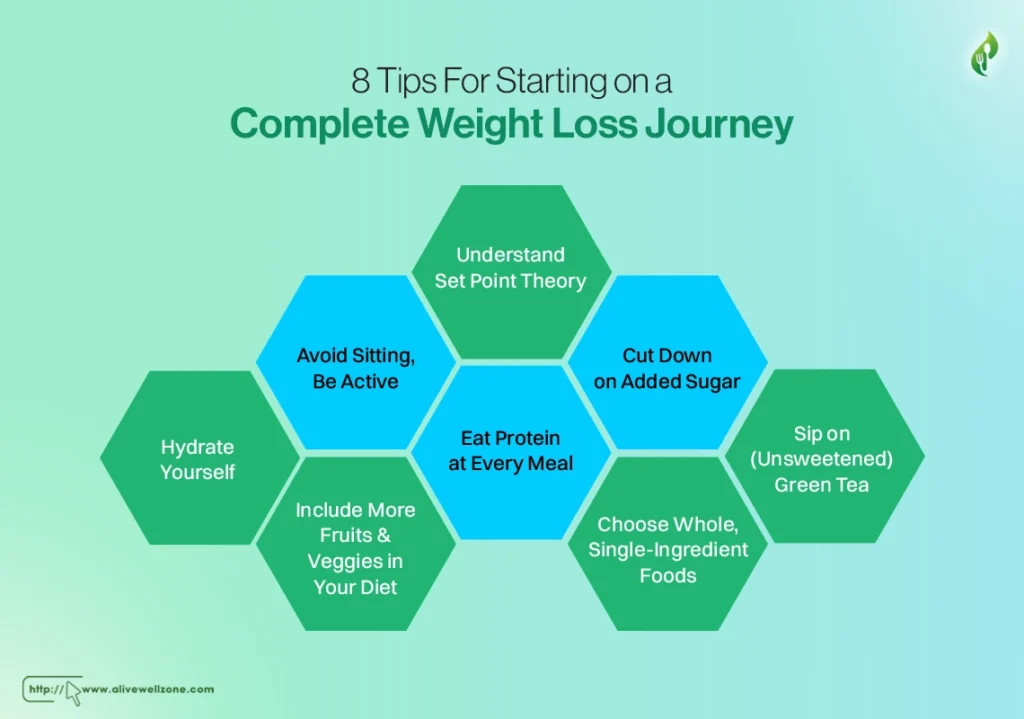
Last Updated on December 5, 2024 by Helena Akter
Diets and workouts leave you disappointed? Cravings and lack of motivation got you down? First of all, stop the swinging dieting!
Look, complete weight loss isn’t just about the number on the scale. It’s about feeling your best and having more energy for the things you love. Besides, it can reduce your risk of serious conditions like type 2 diabetes and heart disease.
From here, you’ll learn practical tips and strategies for losing weight completely. We’ll cover everything you need to know about making lasting changes and losing weight.
Why Is Weight Loss So Complicated?
Losing weight isn’t as simple as eating less or moving more. It’s a puzzle with many pieces, including your genes, medical background, how active you are, stress levels, sleep quality, diet, and blood sugar control.
You might hit a weight loss plateau, crave certain foods, lose your drive, or feel exhausted. These hurdles don’t always mean you’re stuck; sometimes, your body just needs a breather to adapt to the new routine.
Besides, if you reach a healthy weight, it’s good for your overall well-being and can lower your chances of getting type 2 diabetes. To put it in perspective, 38% of adults in the U.S. are on the verge of diabetes, and 11.3% already have it.
So, as you make your weight loss journey, remember to be patient and flexible, keeping in mind these intricacies.
8 Tips For Starting on a Complete Weight Loss Journey
The CDC reports that nearly 41.9 percent of adults in the U.S. are obese. Since 1999, this figure has risen by over 11 percent, indicating a growing trend in obesity and overweight conditions.
That’s why follow the given tips to achieve your weight loss goals —

1. Understand Set Point Theory
Your body loves balance. It keeps your body temperature around 98.6°F and your blood pH at 7.4, just like it keeps your weight within a certain range, known as your set point.
But for reasons scientists don’t fully understand yet, this range tends to shift up more easily than down.
A 2022 study in Obesity showed that women who lost 16% of their weight also saw their metabolic rate drop, meaning they burned fewer calories when at rest. Moreover, a 2021 study in NPJ Breast Cancer found that weight loss can increase levels of ghrelin, the hormone that makes you feel hungry.
But don’t lose hope. You can lower your set point. There are plenty of success stories, like those from the National Weight Control Registry, showing that significant weight loss and keeping it off are achievable.
To lower your set point, try losing 5% to 10% of your body weight first. Keep this new weight for six months before trying to lose more. This stage is key, as it’s when many people find it hard or turn to extreme diets.
But if you stick with it, you can keep the cycle going and gradually lower your set point with small, lasting changes to your habits. This way, you can keep a lower weight over the long term.
2. Avoid Sitting, Be Active
Staying active is vital to complete weight loss. The more you move, the more calories you burn. Plus, working out lifts your spirits, strengthens your heart, and helps control your blood pressure.
Walking is an easy and effective form of exercise. So, try to fit in a brisk 30-minute walk on most days. If you’re pressed for time, weave activity into your daily routine. Opt for the stairs over the elevator, park a bit further from the store, or even find ways to work out while sitting on your couch.
Even small changes can significantly boost your overall activity level.”
3. Hydrate Yourself
Drinking water can help you lose weight. Yes, it can!
If you drink 0.5 liters (17 oz) of water, you can increase your calorie burn by 24 to 30% for the next hour. Having water before meals can also help you eat less, especially if you’re middle-aged or older.

Swapping high-calorie, sweet drinks with water is a great strategy for weight loss. It not only reduces unnecessary calories but also keeps you safe from dehydration’s impact.
4. Include More Fruits and Veggies in Your Diet
Adding more fruits and vegetables to your diet is crucial. These foods are low in calories and fat but high in fiber, vitamins, and minerals. Foods rich in fiber help you feel full, which can assist in weight loss.
You can also get fiber from whole grains, brown rice, beans, and lentils. Plus, choose lean meats, low-fat or fat-free dairy, and healthy fats. And stay away from sugary drinks and processed foods that are high in added sugars and saturated fats.
By focusing on foods packed with nutrients, you can support your overall health and manage your weight.
5. Eat Protein at Every Meal
Make sure to have protein in all your meals, breakfast being the most important. A study in 2021 published in Nutrients showed that a breakfast rich in protein can help curb cravings and reduce how much you eat later in the day.
Plus, protein slows down the release of the hunger hormone ghrelin and takes longer to digest, helping you feel full for a longer time.
When you pair protein with carbs, it helps keep your blood sugar levels steady, preventing sudden drops in energy. So, try to get about 20 grams of protein in each meal. For instance, Greek yogurt has 16 grams of protein per serving and goes well with fiber-filled berries.
A serving of three ounces of cooked chicken gives you 26 grams of protein. If you’re vegetarian, beans are a great source of protein. Including protein, fiber, and healthy fats in every meal can help manage your weight and keep you feeling satisfied.
6. Cut Down on Added Sugar
Eating too much added sugar can lead to serious health problems like heart disease, diabetes, and cancer. The Federal guidelines recommend that you should get less than 10% of your daily calories from added sugars.
But, most people eat more sugar than they should. On average, men eat 19 teaspoons and women eat 15 teaspoons of added sugar every day. Also, 60% of Americans over the age of 2 eat more sugar than recommended. It can be hard to know how much sugar you’re eating because it’s listed under different names on food labels.
You can improve your diet and your health by eating less added sugar. Try to make a conscious effort to eat fewer sweet foods and drinks.’
7. Choose Whole, Single-Ingredient Foods
One of the best ways to improve your health is to base your diet on whole, single-ingredient foods. This method cuts out most added sugars, fats, and processed foods from your diet. Whole foods are naturally satisfying, helping you stay within your calorie limits.
Plus, they provide the essential nutrients your body needs to function properly. A nice side effect is that you often lose weight naturally when you eat whole foods. Opt for fresh fruits, vegetables, lean meats, and whole grains for a balanced, nutrient-rich diet.
8. Sip on (Unsweetened) Green Tea
Unsweetened green tea is a natural drink packed with antioxidants. It offers many health benefits, including boosting fat burning and aiding weight loss. It can increase energy use by 4% and increase fat burning by up to 17%, particularly targeting harmful belly fat.
Matcha tea, a powdered version of green tea, may have even more health benefits than regular green tea. Add unsweetened green tea to your daily routine for a healthy, refreshing beverage that supports weight management and overall well-being.
Remember, green tea is a natural drink full of antioxidants and is associated with many benefits, such as increased fat-burning and weight loss.
How to Stay Disciplined to Lose Weight?
Staying focused on your weight loss journey is key to success. Being disciplined helps you stick to your plan and reach your goals.
Here are some tips to keep you motivated and on track.

1. Set Achievable Goals
Weight loss requires clear, reachable goals. Concentrate on realistic and measurable process goals.
For example, instead of trying to “lose 5 pounds in two weeks,” set a goal like “walk for 15 minutes every day this week” or “eat five servings of fruits and vegetables daily.”
These process goals help you objectively track progress and maintain discipline on your weight loss journey. By breaking your goals into smaller steps, you stay motivated and on track.
2. Try New Activities
You might be good at certain physical activities because of your natural abilities. For example, if you’re naturally flexible, yoga might be easy for you, while those with natural strength might like lifting weights.
But, to lose weight effectively, it’s important to try new activities that challenge your body. Different workouts make your body adapt, burn more calories, and promote weight loss.
So, don’t be afraid to try different exercises to see better results.
3. Get Rid of Distractions and Temptations
Even if you have a lot of willpower, it’s easier to get rid of distractions and temptations than to resist them. For instance, if your phone distracts you during your workout, leave it in a gym locker. Or face a wall if outside views distract you.
Also, try not to keep unhealthy snacks at home where you can easily reach them. If there’s no cake at home, you won’t be able to eat it late at night. By getting rid of these temptations, you make it easier to focus on your weight loss goals.
4. Celebrate Your Small Victories
Losing weight isn’t just about the number on the scale. It’s also important to celebrate your small victories along the way. These small wins can help you stay motivated and make healthier choices more often.
Small victories could be things like eating breakfast every day, not skipping meals, or reaching your daily step goal with a fitness tracker. Whenever you feel down, remember to celebrate these small wins.
Over time, they add up and lead to bigger successes.
5. Mix Up Your Exercise Routine
Doing the same workout over and over can lead to boredom as your body gets used to it and it becomes less effective. To prevent this, mix up your exercise routine. It keeps your workouts interesting and ensures you keep making progress.
You don’t need to buy new gym equipment to change things up. It’s all about making small changes!
Even at home, you can lose weight, try new exercises, or change the intensity. Include different types of activities to keep challenging your body and stay motivated.
6. Keep a Positive Attitude
Keeping a positive mindset is key during your weight loss journey. There will be good days and bad days, but it’s important to stick to your plan no matter what happens. Success comes from being able to make lifestyle changes that last.
Don’t let negative thoughts stop your progress. Instead, focus on the positive changes you’ve made and remind yourself of what you’ve achieved. Staying positive helps stop you from going back to old habits and keeps you moving forward.
Remember, you’ve got this!
7. Be Part of a Fitness Community
Being accountable is key to developing healthy habits. When you share your goals with friends and communities who support you, it can have a big impact.
Interestingly, a study in the US found that if you commit to a goal and tell someone about it, your chances of achieving it increase to 65%.

Now, you can do that both online and offline. The knowledge that others are relying on you can deter you from missing workouts or eating unhealthy foods. Consider going to the gym with friends or posting your workout progress in an online group.
How Much Weight Can You Safely Lose in a Month?
Weight loss requires commitment and consistency. A practical target is to aim for a loss of one to two pounds per week.
Let’s break down the numbers —
A pound of fat is equivalent to 3,500 calories. To shed a pound in a week, you need to burn 500 calories more than what you eat every day. It means burning an extra 500 calories each day for seven days, which totals 3,500 calories.
If this sounds challenging, remember that reducing your body weight by just five to ten per cent can significantly lower your risk of —
- Chronic diseases like heart disease
- Type 2 diabetes
- High blood pressure
Achieving and maintaining a healthy weight can also improve your overall health, increase your energy levels, and enhance your mood.
Final Words
In your complete weight loss journey, remember that it’s a complex process involving many factors like genetics, diet, and activity levels. You must stay flexible and patient.
Set achievable goals, stay active, drink lots of water, and eat a balanced diet to make progress. By celebrating small victories and keeping a positive mindset, you can achieve lasting results.
Through collaboration, you can overcome these challenges and work toward a healthier future. Don’t give up; you’ve got this!
FAQs
Why is losing weight so frustrating?
Losing weight is frustrating because your body actively resists it. Hormones and neurons in the hypothalamus work against weight loss. Diet plays a crucial role, but factors like hormones also affect how your body processes food, making weight loss more complex than just calorie counting.
Is Your Diet Important for Weight Loss?
Your diet is crucial for weight loss, but it’s more complex than just eating fewer calories. Different foods impact your body differently, and factors like hormones also play a significant role. Effective weight loss involves more than the simple “calories in, calories out” approach.
Where does the fat go when you lose weight?
When you lose weight, fat gets broken down into energy, carbon dioxide, and water. Most of the fat leaves your body through breathing out carbon dioxide and excreting water via sweat, breath, and urine.







